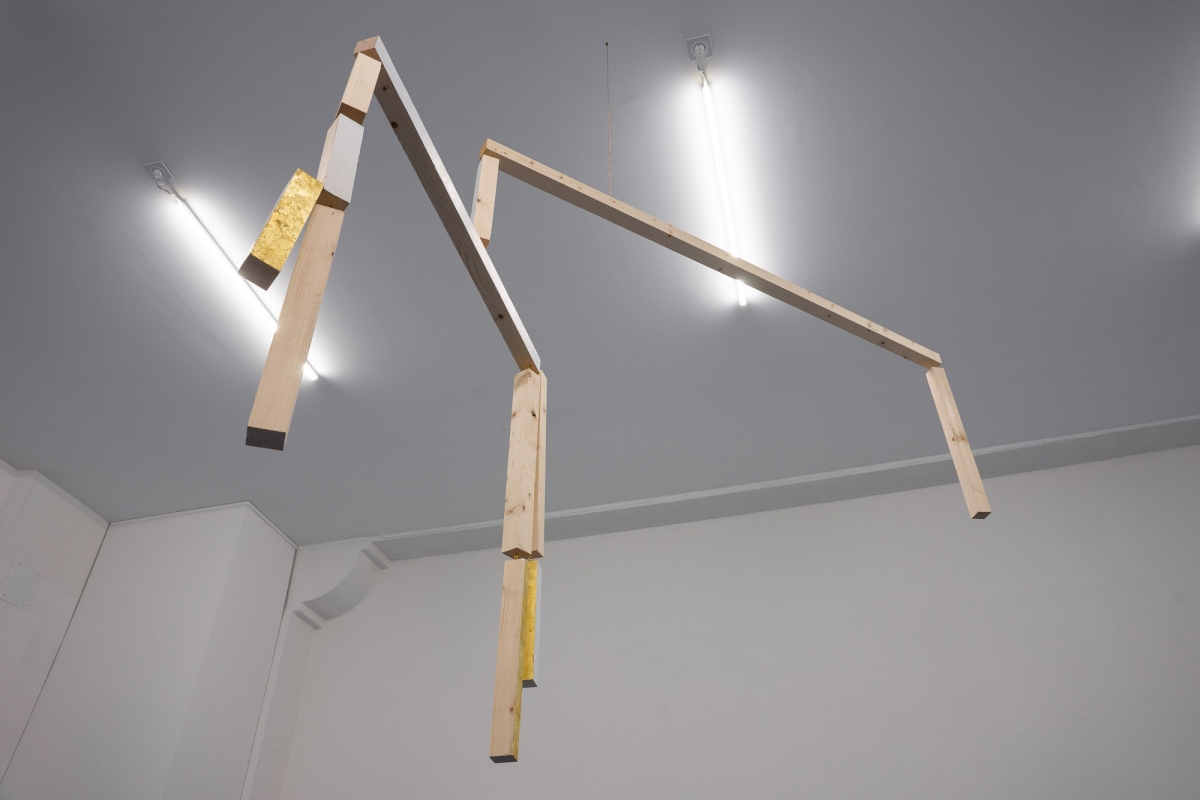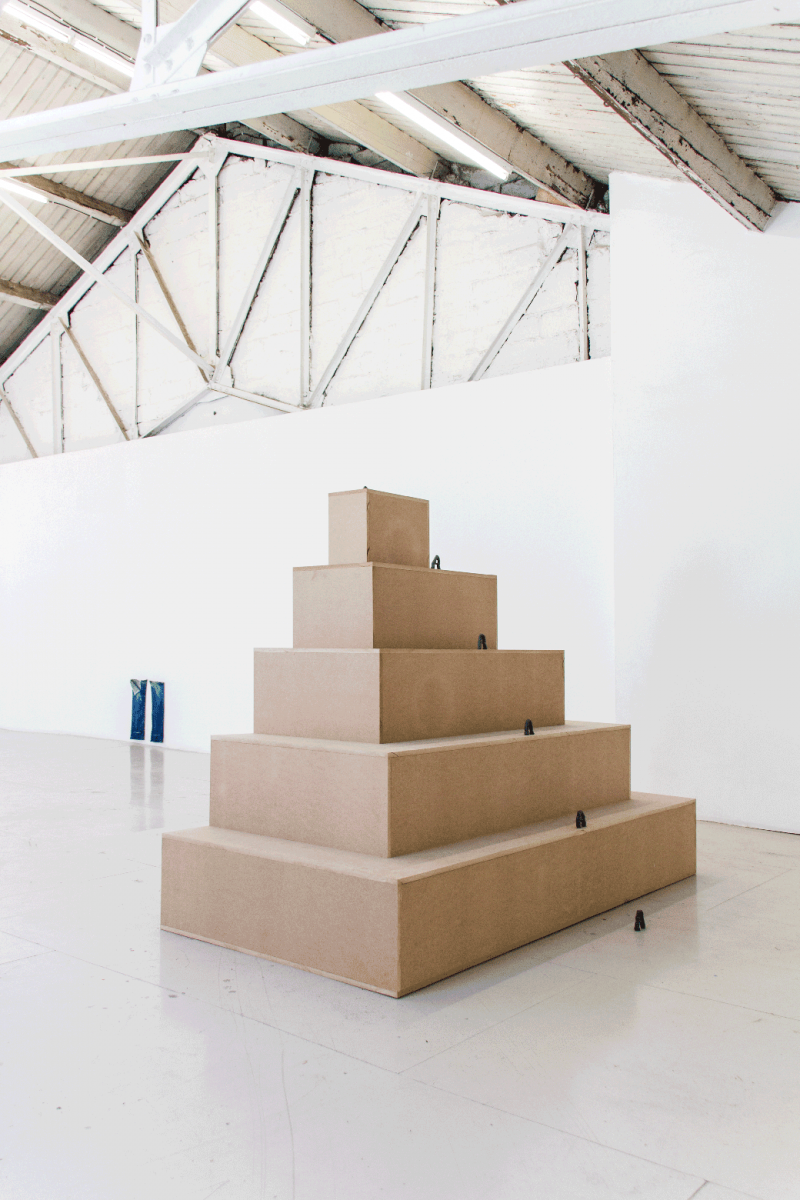Smaranda Olcèse: The exhibition that you are presenting at the Centre d’art de Privas is the third chapter in a long-term research project influenced by your trip to Mexico in 2015. Could you tell us about the process at work, as well as about the two previous chapters, (S)CRYPTE and Transpoème?
Sergio Verastegui: The research project in Mexico consisted of following the trails of three rather ghostly figures, between reality and fiction: Ulises Lima, the protagonist of Roberto Bolaño’s novel The Savage Detectives; Robert Smithson, notably during his stay at Hotel Palenque; and Xipe Totec, ‘The Flayed One’, a Pre-Columbian god represented dressed in a human skin worn backwards. The project involved exploring the content that emerged from this very personal investigation. This content – narratives, initially – crystallized around several works and compositions that I subsequently organised in the form of exhibitions. I devised the project like a film in several chapters. The first two episodes took place at the same time, in 2018: (S)CRYPTE at the Galerie Thomas Bernard – Cortex Athletico and Transpoème at Ateliers Vortex in Dijon. It was interesting to interrelate the forms, displays, and contexts between these two spaces.
SO: A single, capital letter, with evocative resonance, “R”. How did you chose the title of this third chapter?
SV: For some time now, I have wanted very short names. Hence my exhibition How (Galerie Thomas Bernard – Cortex Athletico, 2019) initiates a line of questioning or starts an address, with the idea that the chapter that follows, the one held at the Centre d’art de Privas will be entitled U, so that these three titles form a sentence How R U, a kind of “subliminal message”. R, first letter of the word “retable”, also calls for the idea of errancy, wandering, taking a stroll. In a certain sense, this exhibition was located at the intersection between two research topics: on the one hand, the Mexican journey and on the other, the concrete poetry aspect, which is still present in my work today.
SO: In what ways did the relationship between the text and the materiality of the objects and sculptural situations play out in R?
SV: I always try to combine the question of language with the materiality of sculpture: to force language to become a material in different ways, to become something that seeks to signify. In (S)CRYPTE, the notes accumulated on the trip to Mexico acquired a material status similar to the form of the palimpsest, whereas Transpoème played on sampling words from poems by Mario Santiago Papasquiaro, to build graphic pyramids that fragmented the words.
R proposes something that’s a bit more austere, less chatty than the two previous chapters. I try to match the forms that are already there. There’s a lot less talk. The additional materiality of language and narration, of a form of fiction, is certainly present, inherent in these objects themselves, without however constituting my focal point. I would like the visitor to be able to see the things for what they are. I imagine a situation similar to minimalist sculptures: seemingly simple objects that present complications within their complicity.
SO: You place the anti-retables at the heart of the exhibition at the Centre d’art de Privas. Where does this notion come from and how do you approach it?
SV: The way in which these sculptural works are named determined their status for me from the outset: anti-retables. They refer to a whole religious tradition in Western art, that gives rise to mini altars, midway between object and painting. These anti-retables emerged from the start of the Mexican research and function as a vanishing point: removed from the project, while also being connected to it. Thanks to my encounter with this word in a poem by Mario Santiago Papasquiaro, the machine was set in motion: I had to materialise the anti-retable, to imagine it. It is a speculative module, of course, a sculpture, but above all it is a tool that enables a different experience. It must be manipulated and, through its articulations, it does not have a frozen form – it can be moved, and can itself affect the various ways that we explore and project ourselves within space. Anti-retable thus foils the relationship between interior and exterior.
SO: You built these anti-retables from measurements based on the articulations of your own body. What does this anthropometric approach say about your relationship to the objects?
SV: I was interested in this analogy between the articulation of the body and the articulation of language into words or phrases. So I proceeded with this logic into the space. What is a body? What is an object? From which the whole problematic of anthropometries derives. Ilya Prigogine, a researcher in quantum physics and Nobel Prize winner, highlights the fact that protocols of measurement only take themselves into account, since reality is very complex, impossible to measure. This brings us back to an awareness of fragility at the very moment when we think we know something.
SO: How would you define your relationship to the fragment and the temporality of an artwork?
SV: The fragment is clearly a key for entering the work. I am interested in this fragmented relationship to the body and, at the same time, to writing. Consequently, I maintain a fragmented relationship to sculpture and to the experience of space and therefore to the experience of time. I understand temporality not in a linear way, but dispersed, with leaps from the past into the future, interruptions, improbable circulation, like an aperiodic crystal1 involving all possible future states.
SO: The gold leaf partially covering the monumental mobile that you created for the spaces of the Centre d’art de Privas mingles with some ‘poor’ materials, from everyday life. What is the status of materials in your work?
SV: The gold that covers this mobile allows me to return to a religious pictorial tradition, strengthening the reference to retables that contributes to the colonial narrative and evoking the process of erasure, through which one religion conceals the ancestrality of another. The gold leaf conveys something magical. It’s like a skin coating the objects, a skin that is being shed.
Also, it’s natural for me to work with ‘poor’ forms since a grew up in an environment that was not especially wealthy. I situate my work in closer proximity with that of Roberto Bolaño and Mario Santiago Papasquiaro who are called ‘infra-realists’. It is a matter of rendering these sculptures fragile, unprotected, in a situation of potential danger, or a bit wretched. The materials or situations are halfway between debris (something that shouldn’t be there, in an exhibition space) and disrepair. For me, attracting attention to these situations involves a kind of poetry. I’m looking on the one hand for a kind of ancestrality that I cannot understand, that no longer exists, that is buried. Everything that we have are remains, fragments of disconnected myths and repressed notions. I’m talking about something that I belong to, while also being expulsed from it.








